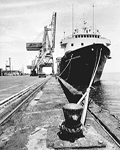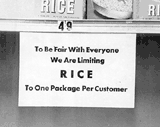By Curtis Lum
Advertiser Staff Writer
History has shown that the threatened statewide dock strike this week could be a crippling blow to the state’s already struggling economy.
Hawaii is almost totally dependent on the shipping industry, with about 90 percent of the goods consumed here brought in by ships. Two lengthy dock strikes in the 1940s and 1970s proved how vulnerable the islands can be.
One of the most costliest strikes began on May 1, 1949, when 2,000 members of the International Longshoremen’s and Warehousemen’s Union (ILWU) walked off their jobs over a pay dispute. The strike, which lasted 178 days, came as the state was recovering from a 1946 statewide strike by plantation workers.
The 1949 strike forced many small businesses to go bankrupt because they could not receive goods from the Mainland. At that time, there were very few airlines serving the islands.
Unemployment soared, food shortages developed, sugar and canned pineapple sat in warehouses, and the community was divided by anti-union sentiment. Violence erupted on several occasions, including one event in July 1949 when hundreds of picketers stormed the non-union hiring hall of the Hawaii Stevedores.
The workers had sought wages comparable to West Coast workers (a raise of about 32 cents an hour), but when the strike was finally settled, the laborers agreed to an increase of just 14 cents an hour.
The great West Coast dock strike of 1971 will long be remembered by local residents as the year that toilet paper rolls went empty.
The strike began on July 1, when 15,000 dock workers in 24 ports on the West Coast walked off their jobs. The work stoppage spanned 134 days.
As in 1949, store shelves slowly went bare, businesses crumbled and people lost their jobs. But one of the rarest commodities at that time was toilet paper because residents hoarded rolls as supplies began to dwindle.
The strike was temporarily halted in October 1971 when President Nixon invoked the Taft-Hartley Act. But the 80-day cooling off period expired on Christmas Day and the dockers resumed the strike on January 17, 1972.
In February 1972, negotiators for the ILWU and the employers, Pacific Maritime Association, reached a tentative agreement that brought the strike to an end.
|



